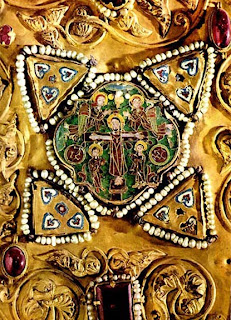| Modern Georgian Icons for sale. |
By Edith McClintock
Icons are representations, most commonly paintings, used for prayer and teaching moral and spiritual lessons. They’re widely used in Eastern Orthodox religions and are extremely popular within the Georgian Orthodox Church. Most homes in Georgia display icons in a prayer area—often twenty or thirty devotional images of Jesus, Mary, St. Nino and the Georgian Orthodox Patriarch covering multiple walls.
Icons are representations, most commonly paintings, used for prayer and teaching moral and spiritual lessons. They’re widely used in Eastern Orthodox religions and are extremely popular within the Georgian Orthodox Church. Most homes in Georgia display icons in a prayer area—often twenty or thirty devotional images of Jesus, Mary, St. Nino and the Georgian Orthodox Patriarch covering multiple walls.
Icons are
important in Georgian history and the country’s most beautiful and rare cloisonné
enamel icons, many previously lost or stolen from Orthodox churches in Georgia
and Turkey and dispersed to museums and private collections throughout the
world, are now exhibited at the Shalva Amiranashvili Museum of Fine Arts in Tbilisi.
The 8th-12th century icons are both great works of art as
well as religious relics imbued with nationalistic and religious symbolism and special powers
of healing and miraculous events.
On the
artistic side, cloisonné is an ancient technique first developed in the
Middle East and Ancient Egypt for decorating metalwork such as jewelry. Geometric
decorations were formed by soldering silver or gold strips to metal objects to
create compartments of enamel or gems in a variety of beautiful
colors (see the pectoral jewels of Tutankhamun on left).
In the
Byzantine Empire, thinner wires were developed which allowed more detailed
representations commonly found in icons. Byzantium icons became a highly developed art
form that spread to Italy and Ethiopia and Georgia and beyond. In Georgia, Byzantine
techniques were adapted and became a distinctive school, but both Byzantine and
Georgian icon styles are represented in the museum.
When a
Georgian friend invited me to see the icon exhibit (as she referred to it,
although there were plenty of crosses and jewelry too) at the museum, it wasn’t for artistic reasons. Her interest was religious, which is why
she thought the church rather than the national government should own and house
the icons. She expressed her opinion at great length and volume to our tour
guide while I studied the pretty jewelry, sure we’d soon be tossed out
of the museum.
 |
| Khakhuli triptych, Georgian & Byzantine cloisonné enamel, 8th-12th Century |
We weren’t,
and eventually we moved on to the history and symbolism of each icon (usually told with miraculous and nationalistic elements) followed by prayers, although given
it was a museum we didn’t light and leave a candle in front of each icon as is
the tradition in Georgian churches.
According to the
Western Christian cannon, icons in early Christianity were considered graven
images and therefore forbidden by the Ten Commandments. However, they also became
a tool for teaching illiterate populations and their popularity spread. It
wasn’t until the Reformation and Counter-Reformation of the 16th and
17th centuries that the popularity of icons in the West declined,
although less so within Catholicism.
In
contrast, Eastern Orthodoxy teaches that icons have been an important and
unchanging part of the church since the beginning and continue to have deep religious significance.
Veneration of an icon passes to the original so that kissing an icon of Jesus demonstrates love directly to Jesus himself, not just to the representational gold
and cloisonné enamel or paint and woodwork.
But whether you visit the Museum of Fine Arts in Tbilisi for religious, artistic, or nationalist reasons, you won't be disappointed.
But whether you visit the Museum of Fine Arts in Tbilisi for religious, artistic, or nationalist reasons, you won't be disappointed.
 |
| Detail of Khakhuli triptych, 8th-12th Century |
| Detail of Khakhuli triptych, 8th-12th Century |
| Ancha Icon of the Savior triptych, medieval Georgian encaustic (made with hot wax painting) 6th-7th Century |

These are lovely works of religious art, Edith. How lucky you were to see them in the museum.
ReplyDeleteThank you for sharing these beautiful icons with us. What a treat to have a guided tour of the exhibition.
ReplyDeleteThese are gorgeous!
ReplyDelete